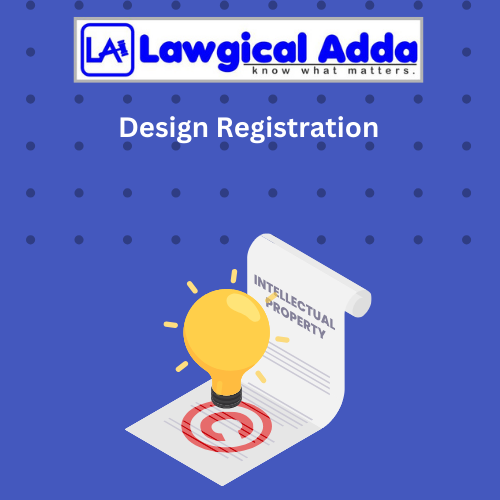
Design Registration
In India, registering designs is an important part of protecting intellectual property and Lawgical India is here to help you with the same!
Documents Needed to Register a Design
- A certified reproduction of the original document or certified copies of the disclaimer extracts
- For a price, affidavits, declarations, and other public papers can be accessed.
- A statement of truth and verifiability should be included in each paragraph of the affidavits. The Controller may set limits on the expenditures associated with the design registration procedure in accordance with the Fourth Schedule.
| Pricing Summary | |
| Service Price: | ₹10000 |
| GST: | ₹1800 |
| Total | ₹11800 |
| Place Order | |
Have a Question?
Design Registration in India
In India, registering designs is an important part of protecting intellectual property. For creators and businesses, registering designs under the Design Act 2000 has become essential due to the growing significance of distinctive and aesthetically pleasing designs. The aim of The Designs Rules, 2001, is to enable protection for freshly produced designs that apply to certain goods manufactured through an industrial process.
"Designs"—what are they?
The unique components of shape, form, patterns, or combinations of these applied to an object, whether in two or three dimensions and utilizing any manufacturing process, are referred to as "design."
A final product that is visually identifiable can be produced by using manual, mechanical, automated, or chemical means, either separately or in combination. It does not include building supplies or standard or mechanical components.
Furthermore, it does not include property marks or creative works as described in Section 2(c) of the Copyright Act of 1957, nor registered trademarks as specified in Section 2(v) of the Trade and Merchandise Marks Act of 1958.
In India, registering a design involves three steps:
Submitting an application: Submitting an application to the Indian Trade Marks Office's Designs Office is the initial step in the design registration procedure. The following information ought to be included in the application:
- The applicant's name and address
- An explanation of the design
- Class and subclass that the design belongs to
- Illustrations or depictions of the design
Application examination: Following filing, the Designs Office will review the application to determine whether it complies with the Designs Act's requirements. If it is determined to be in order, the application will be published in the Designs Journal.
Registration approval: The Design Office will approve the design's registration if no complaints or oppositions are voiced within the allotted time frame. After the filing date, a registration certificate that is good for ten years will be provided.
Essential Conditions for India's Design Registration
The following prerequisites must be met in order for a design to be registered and protected under the Design Act of 2000:
Aspect of Novelty
The design needs to include a novelty element, which means it needs to be fresh and unregistered. If combining registered designs results in a novel visual appearance, it may be taken into consideration.
Not Published Before
The design should never have been made public in India or around the world, either through prior use or by any other means.
Utilizing Design in an Article
The article itself ought to incorporate the design. Without an actual article, registration is not possible.
Observance of morality, public order, and security
The design shouldn't conflict with Indian security, morality, or public order. Designs that are forbidden by law or by any recognized organization, or that go against popular opinion, might not be allowed to be registered.
Documents Needed to Register a Design
- A certified reproduction of the original document or certified copies of the disclaimer extracts
- For a price, affidavits, declarations, and other public papers can be accessed.
- A statement of truth and verifiability should be included in each paragraph of the affidavits. The Controller may set limits on the expenditures associated with the design registration procedure in accordance with the Fourth Schedule.
Location for Design Registration Application
If you wish to register a design, the following paperwork must be submitted to the Controller of Designs at The Patent Office in Kolkata, or any of its regional offices in New Delhi, Mumbai, or Chennai.
The amount of time a design has been registered and renewed
A design's initial registration period is ten years from the date of registration; however, in situations where priority claims have been granted, the period is ten years from the date of priority. Before the aforementioned initial copyright time expires, this initial registration period may be extended by an additional five years upon application in Form-3 and payment of Rs. 2,000/-to the Controller. As soon as a design is registered, the design owner may apply for this kind of extension.
The unauthorized use of a design
The application of a design or its imitation to any object that is part of a class of articles for which the design has been registered for the intention of selling or importing such articles without the registered proprietor's express agreement is known as "piracy of a design." Design piracy also includes publishing such articles or offering them for sale while knowing that the design has been applied to them without authorization.
Conclusion
In India, registering designs is essential for safeguarding their distinctiveness and marketability. Designers can make sure that their works are protected from unauthorized duplication or imitation by others by registering them under the Design Act 2000. Completing the registration process entails meeting prerequisites including novelty, distinctiveness, and article application.
Important elements in the registration process include creating representations, categorizing designs, and conducting a prior art search. Important elements include resolving objections, paying fees, and passing the examination phase. A design that has been registered is granted unique rights, which can be utilized to increase its marketability, bring in money, or prevent infringement.